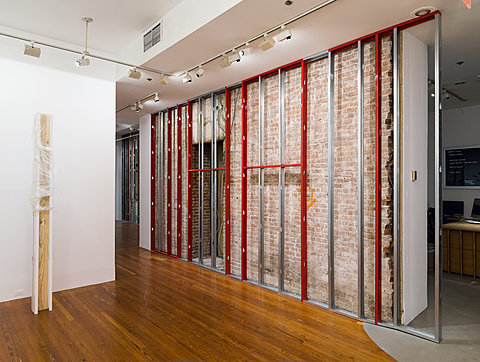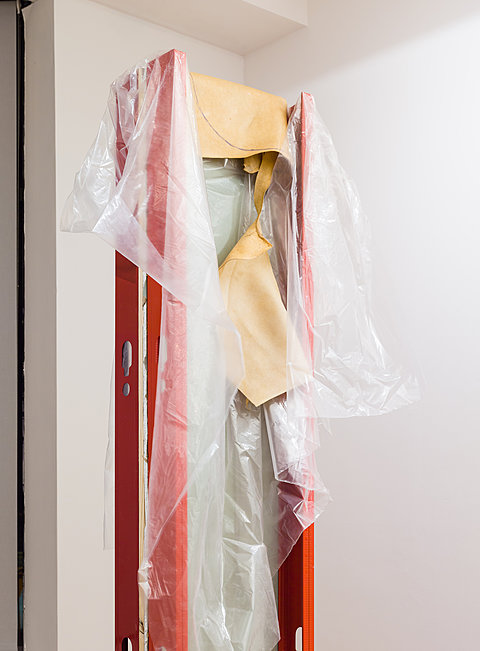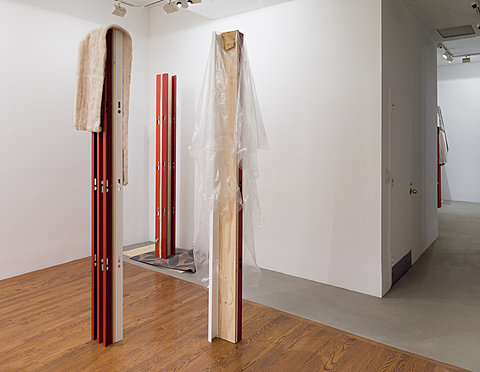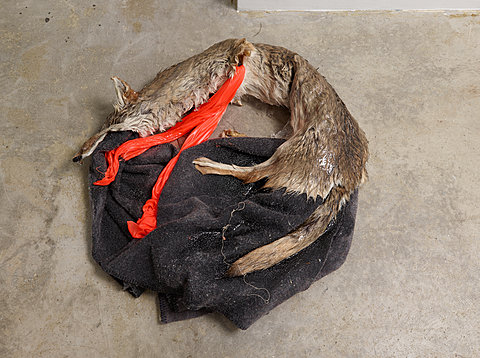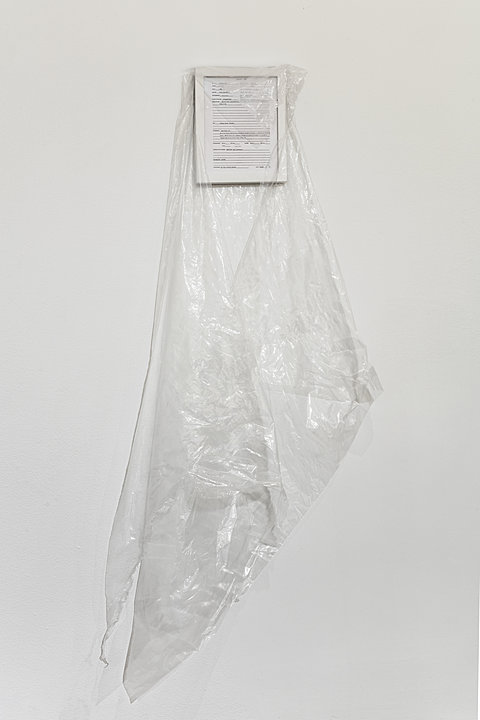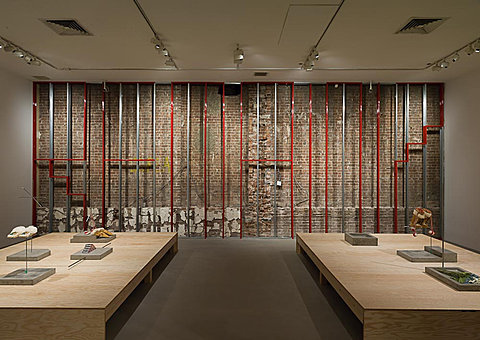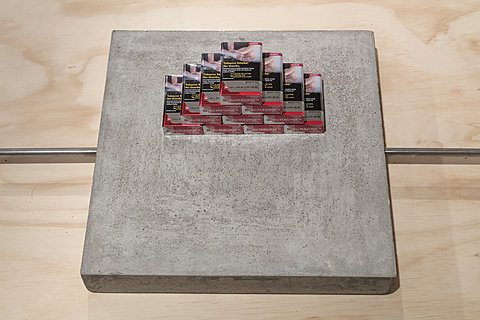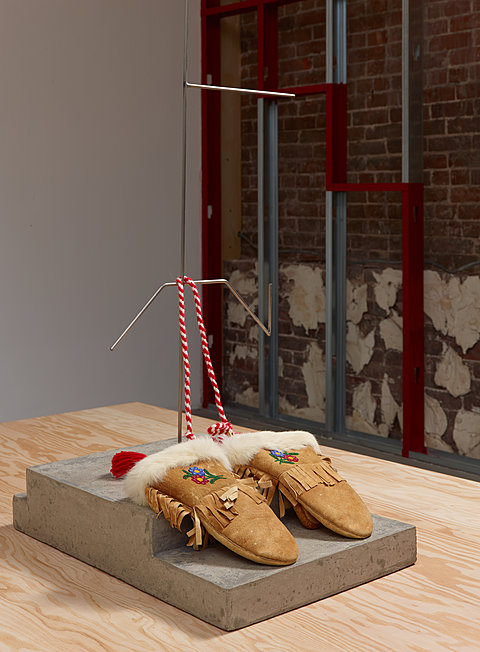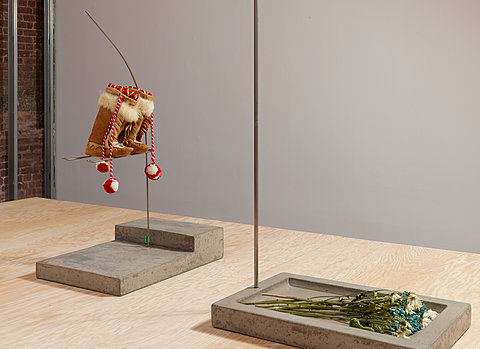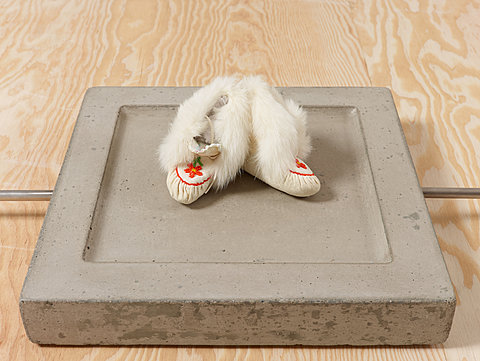With Ethel Linklater (Trapper) and Tobias Linklater.
This exhibition features a series of new works including a large-scale architectural intervention that runs through all five galleries. This structural response explores the internal language of walls, the spaces for the Indigenous body, and how spaces of inclusion can be extended. The introduction of works by Duane’s late paternal grandmother Ethel Linklater and his twelve-year old son Tobias unearths his familial framework, the migration and exchange of knowledge and ideas, and their consequences.
The title From Our Hands refers to an exhibition which toured Ontario between 1982 and 1985 presenting Indigenous craft, including the work of Ethel Linklater, which will be re-presented within the galleries and displayed on museum-style steel and concrete armatures. The placement of these objects in the installation instigates questions around the exclusion of craft and the handmade from fine art discourses. Moreover, it reflects on concepts of lineage, Indigenous history and cultural property. The process of the loan, shipping and customs negotiation for Ethel’s objects—caribou-hide and rabbit-fur mitts, slippers, mukluks and baby boots—from the Thunder Bay Art Gallery at Duane’s request mobilizes present day relations of cultural heritage while highlighting traces of genealogy and questions of legacy.
Ubiquitous materials of construction, gypsum, plywood and steel mined and extracted from the land are repurposed in a series of 8 foot high sculptures, their span mimicking that of Duane’s chest and height with extended arms. This act recalls the opening lines in Audra Simpson’s Mohawk Interruptus: Political Life Across the Border of Settler States when she describes the role of ironworkers from Kahnawàke who built the infrastructure for skyscrapers, bridges, and other large scale jobs in cities across the Northeastern United States traveling on Sunday nights to start work on Monday mornings. This series of sculptures, Untitled Problems, are draped with discarded elk and bison hides, offcuts from a native crafts store, plastic and a faux fur scarf, and are presented in clusters in the front three galleries as a form of occupation.
The large-scale architectural intervention in the galleries has removed and replaced the gallery walls, and introduces a sentence questioning Indigenous sovereignty of land, law, and legacy. During the installation the drywall, plywood, and steel studs along the length of three gallery walls have been removed. The structure of the gallery has been physically altered and extended. This has been replaced with new steel studs, in a skeletal form, powder coated in a fire engine red at specific intervals to form for the words, 'WHAT THEN REMAINS' with each word occupying one full wall. This text ‘WHAT THEN REMAINS’ is an excerpt from a 2015 statement by Justice Sonia Sotomayor in the closing remarks of the United States Supreme Court case Dollar General v Mississippi Band of Choctaw Indians. When a thirteen year-old tribal member on the training program alleged abuse by a non-Indian employee on the company’s store on tribal land. At the core of the case was the legal principal that tribal courts have civil jurisdiction over non-Indian conduct arising from consensual relations on Indian reservations, weaving through overriding sovereignties across territories and bodies, and, critically, Indigenous sovereignty. The walls of 80 Washington Square East Gallery have not been opened since its construction in 1974 and following the close of the exhibition the new powder coated steel studs will be plastered over to reinstate the gallery walls, becoming a permanent yet unseen presence in the gallery. Their residue will remain.
Within Washington Square, images of Duane Linklater’s studio in North Bay, Ontario, will be installed and illuminated in the gallery’s Washington Square Windows. Duane Linklater, Tanya Linklater and cheyanne turions are the current members of the Wood Land School an artist-led initiative addressing the lack of visibility and critical writing on the works of contemporary Indigenous artists. This exhibition also coincides with the launch of the first Wood Land School critical anthology.
The Wood Land School was established in 2011, originating in Duane Linklater’s North Bay studio current members also include Tanya Linklater and cheyanne turions. It is an ongoing project with no fixed location or form. It seeks critical engagement within the realms of representation, film, contemporary art, land and politics in Turtle Island and beyond. Each iteration of Wood Land School carries forth with it a commitment to address the lack of structural inclusion, both historically and in the now in a multiplicity of institutional spaces. It is a conceptual and physical space for indigenous people, with indigenous people deciding its direction and structure. Pip Day, Director of SBC Gallery of Contemporary Art in Montreal, has invited the Wood Land School to take over the institution for 2017. This exhibition also coincides with the launch of the first Wood Land School critical anthology co-published by OR Gallery and SFU Galleries in 2017.
This exhibition originated at Mercer Union, a centre for contemporary art, Toronto with support from Partners In Art. The presentation at 80 Washington Square East is curated by Georgina Jackson (Director of Exhibitions & Programs, Mercer Union) and Nicola Lees with Georgia Harrell, 80WSE.
